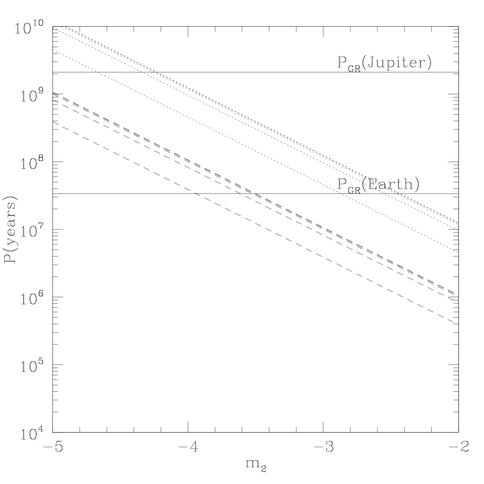2009 Annual Science Report
 Pennsylvania State University
Reporting | JUL 2008 – AUG 2009
Pennsylvania State University
Reporting | JUL 2008 – AUG 2009
Biosignatures in Extraterrestrial Settings
Project Summary
This project looks at the evolution of the composition of gases in the cold disk from which planets form; the evolution of the atmosphere after planet formation, in particular, the role of trace gases in the early greenhouse effect; and, some aspects of the the formation and later dynamical evolution of extrasolar planets.
Project Progress
4.1.1 We have made significant progress on this work: a paper on the NO2 warming mechanism was submitted . The reviewers made some valid technical comments, which we are now addressing and they advised us to split it into two or three papers.
Recently, we have been concentrating on the SO2 mechanism: 1) We derived thermal-IR absorption coefficients for SO2; 2) photochemical model that can predict the concentrations of sulfate and sulfur aerosols as a function of atmospheric SO2 concentration; 3) derived Mie scattering parameters for sulfate and S8 aerosols and included them in our photochemical and climate models; 4) series of calculations of surface temperature as a function of CO2 partial pressure and SO2 outgassing rate.
4.1.2. Magmatism on young terrestrial planets
Ohmoto presented a paper at the Goldschmidt Conference, suggesting that the volcanic and hydrothermal inputs from the mantle to the atmosphere on early Earth and Mars were dominated by CH4, and that the early life utilized CH4, rather than CO2.
4.2 A collaborative assessment of CO self-shielding in the solar nebula and the presolar molecular cloud showed that 3 environments are viable locations for producing oxygen isotope fractionation consistent with the CAI mixing line. N2 self-shielding can be a source of large 15N enrichment. Critically revisited controversial reports on CO photolysis.
4.3 Graduate student K. Moody, partially supported by PSARC, successfully defended his PhD thesis, including significant work on dynamics of planetary systems. Graduate student Amanda Martin, partially supported by PSARC, submitted a master’s thesis on protoplanetary-like disks around nearby brown dwarfs.
Precession time scales for general relativistic perihelion precession and for classical “Kozai” precession for select planetary masses in a hierarchical configuration.
When the relativistic precession time scale is shorter than the classical precession it dominates over some classical effects. From K. Moody (PhD PSU 2009).
Publications
-
Lyons, J. R., Bergin, E. A., Ciesla, F. J., Davis, A. M., Desch, S. J., Hashizume, K., & Lee, J-E. (2009). Timescales for the evolution of oxygen isotope compositions in the solar nebula. Geochimica et Cosmochimica Acta, 73(17), 4998–5017. doi:10.1016/j.gca.2009.01.041
-
Lyons, J. R., Lewis, R. S., & Clayton, R. N. (2009). Comment on “Experimental Test of Self-Shielding in Vacuum Ultraviolet Photodissociation of CO”. Science, 324(5934), 1516–1516. doi:10.1126/science.1167717
-
Morrow, A. L., Luhman, K. L., Espaillat, C., d’Alessio, P., Adame, L., Calvet, N., … Bohac, C. J. (2008). Observations of Disks around Brown Dwarfs in the TW Hydra Association with the Spitzer Infrared Spectrograph. The Astrophysical Journal, 676(2), L143–L146. doi:10.1086/587462
-
Tian, F., Kasting, J. F., & Solomon, S. C. (2009). Thermal escape of carbon from the early Martian atmosphere. Geophysical Research Letters, 36(2), n/a–n/a. doi:10.1029/2008gl036513
- Moody, K. (2009). Three Body Dynamics in Dense Gravitational Systems. Department of Astronomy. University Park: The Pennsylvania State University.
- Ohmoto, H. (2009). Redox evolution of volcanic gas through geologic time. Goldschmidt conference. Davos, Switzerland.
-
PROJECT INVESTIGATORS:
-
PROJECT MEMBERS:
Mark Claire
Co-Investigator
Edwin Bergin
Collaborator
Fred Ciesla
Collaborator
David Crisp
Collaborator
John Debes
Collaborator
Steven Desch
Collaborator
Avi Mandell
Collaborator
Jacob Haqq-Misra
Doctoral Student
Kenneth Moody
Doctoral Student
Amanda Martin
Graduate Student
Megan Smith
Undergraduate Student
-
RELATED OBJECTIVES:
Objective 1.1
Formation and evolution of habitable planets.
Objective 1.2
Indirect and direct astronomical observations of extrasolar habitable planets.
Objective 2.1
Mars exploration.
Objective 4.1
Earth's early biosphere.


